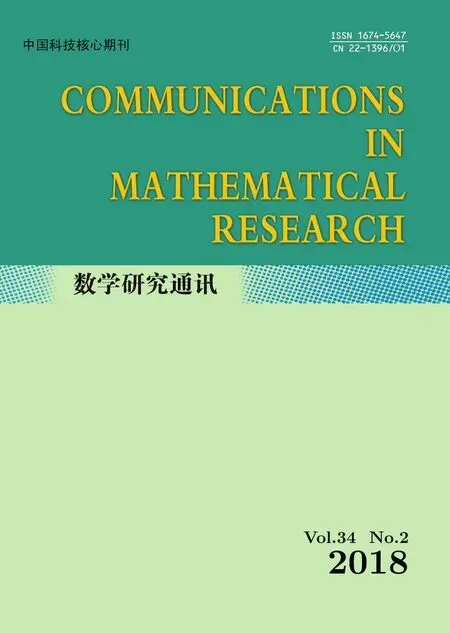Fekete-Szeg? Problem for a Subclass of Meromorphic Functions Defined by the Dziok-Srivastava Operator
GuO DONG,LI ZONG-TAOAND XIONG LIANG-PENG
(1.Foundation Department,Chuzhou Vocational and Technical College,Chuzhou,Anhui,239000)
(2.Foundation Department,Guangzhou Civil Aviation College,Guangzhou,510403)
(3.School of Mathematics and Statistics,Wuhan University,Wuhan,430072)
Communicated by Ji You-qing
1 Introduction and Definition
LetΣdenote the class of meromorphic functions of the form:

which are analytic in the open unit disk

A function f ∈Σis meromorphic starlike of order β,denoted by S?(β),if Re(0≤ β< 1,z∈ U?).A function f∈Σis meromorphic convex of order β,denoted by
Let φ be an analytic function with positive real part in the open unit disk U,φ(0)=1,φ′(0) > 0 and φ(U)be symmetric with respect to the real axis.The Taylor’s series expansion of such function is of the form

Aouf[1]introduced and studied the classwhich consists of functions f(z)∈Σfor

For the functions

let(f?g)(z)be the Hadamard product or convolution of f(z)and g(z)defined by

The generalized hypergeometric functionlFmfor a1, ···,al,d1, ···,dmsuch that dj0,?1,···for j=1,2,···,m,and z ∈ C is defined in[2]as follows:

with l≤ m+1,l,m ∈ N,where the Pochhammer symbol(ν)n(or the shifted factorial since(1)n=n!)is given in terms of the gamma function as

For the positive real values a1, ···,al,d1, ···,dmsuch that dj0,?1,···for j=1,2,···,m,by using the Gaussian hypergeometric function given by(1.4),we thus obtain

where

(see[3]–[5],and also the more recent works[6]–[8]dealing extensively with Dziok-Srivastava operator).
We note that:
(i) The differential operator2I1(a,b;c;z)=()(z)(a,b∈ C,c∈ Z+)was studied by Hohlov[9];
(ii) The differential operator2I1(n+1,1;1;z)=Dnf(z)(n ∈ N+)was studied by Ruscheweyh[10];
(iii) The operator2I1(a,1;c;z)=L(a,c)f(z)was studied by Carson and Shaffer[11];
(iv) The operator2I1(ν,1; λ +1;z)=Iλ,νf(z)(λ > ?1, ν > 0)was studied by Choiet al.[12].
Let H denote the class of function f(z)of the form

which is analytic in the open unit disc U,and S be the subclass of H consisting of functions which are analytic and univalent in U.
Liu and Cui[13]defined a class Mα(φ)consisting of functions f(z)∈ S for which

Analogous to the class Mα(φ),by using the operatorlImf(z),we define the classas follows:
Definition 1.1Letφ(z)=1+B1z+B2z2+B3z3+ ···A functionf(z)∈Σis in theclass

It is interesting to note that,for l=2,m=1,a1=d1,a2=1,the classlM?m(α,φ)reduces to the following new subclasses.
Example 1.1Fora function f(z)∈Σgiven by(1.1)is said to be in the class M(α,φ),if the following conditions are satis fied:

In order to derive our main results,we have to recall here the following lemmas.
Lemma 1.1[14]Let ?be the class of analytic functionsω,normalized byω(0)=0,
satisfying condition|ω(z)|< 1.Ifω(z)∈?andω(z)=c1z+c2z2+ ···,z ∈ U,then

Lemma 1.2[15]Ifω(z)∈?andω(z)=c1z+c2z2+ ···,z ∈ U,then

for any complex numbert.The result is sharp for the functionsω(z)=z2orω(z)=z.
Lemma 1.3[16]Ifω(z)∈?andω(z)=c1z+c2z2+ ···,z ∈ U,then

Fort< ?1ort> 1,the equality holds if and only ifω(z)=zor one of its rotation.For?1 < t< 1,the equality holds ifω(z)=z2or one of its rotation.The equality holds fort= ?1if and only ifor one of its rotation.Fort=1,theequality holds if and only ifor one of its rotation.Theabove upper bound for?1<t<1is sharp,and it can be improved as follows:

2 Main Results
Theorem 2.1Letφ(z)=1+B1z+B2z2+B3z3+···Iff(α,φ)andl≤m+1,l,m∈N,then

and

Proof.Let f∈l(α,φ).Then there is an analytic function ω(z)=c1z+c2z2+···such that

Since

and

it follows from(2.1)–(2.3)that

Then,we see that

Taking into account(2.6),(1.6)and Lemma 1.1,we obtain

and,by Lemma 1.2,we have

Also,if B1=0,then
By using(1.6)and Lemma 1.1,we get

Moreover,by using(1.6),(2.6)and Lemma 1.1,we have


which completes the proof.
Now,we consider the Fekete-Szeg? problem for the classl(α,φ).
Theorem 2.2Letφ(z)=1+B1z+B2z2+B3z3+···Iff∈l(α,φ)andl≤m+1,then forμ∈Cwe have
For eachμ,there is a function inl(α,φ)such that the equality holds.
Proof.Applying(2.6),we have

where

Then,by using(1.6),(2.7)and Lemma 1.2,we have

as asserted.An examination of the proof shows that for the first case,the equality is attained when c1=0 and c2=1,where the function inl(α,φ)is given by

and for the second case,when c1=1 and c2=0,we have

respectively.
By using Lemma 1.3,we can obtain the following theorem.
Theorem 2.3Letφ(z)=1+B1z+B2z2+B3z3+ ···(Bi> 0,i∈ N+,α >).Ifandl≤m+1,l,m∈N,then forμ ∈R,we have

where

For eachμ,there is a function inl(α,φ)such that the equality holds.
Proof.By using(2.7),(1.6)and Lemma 1.3 successively,we have

where

To show that these results are sharp,we define the functionssuch that

It is clear that the functionsLetIf u<u1or u>u2,then the equality occurs for the functionor one of its rotations.For u1<u<u2,the equality is attained if and only if f isor one of its rotations.If u=u1,then the equality holds for the functionor one of its rotations.If u=u2,then the equality is obtained for the functionor one of its rotations.
Using arguments similar to those in the proof of Theorem 2.3,we obtain the following theorem.
Theorem 2.4Letφ(z)=1+B1z+B2z2+B3z3+ ···(Bi> 0,i∈ N+,α >)and.Iff(z)given by(1.1)belongs to the classthen forμ∈R,we have

whereμ1andμ2are given in Theorem2.3.
References
[1]Aouf M K,EI-Ashwah R M,Zayed H M.Fekete-szeg? inequalities for certain class of meromorphic functions.J.Egyptian Math.Soc.,2013,21:197–200.
[2]Ponnusamy S,Vuorinen M.Univalence and convexity properties for Gaussian hypergeometric functions.Rocky Mountain J.Math.,2001,31:327–353.
[3]Dziok J,Srivastava H M.Classes of analytic functions associated with the generalized hypergeometric function.Appl.Math.Comput.,1999,103:1–13.
[4]Dziok J,Srivastava H M.Some subclasses of analytic functions with fixed argument of coeffi cients associated with the generalized hypergeometric fuction.Adv.Stud.Contemp.Math.,2002,5:115–125.
[5]Dziok J,Srivastava H M.Certain subclasses of analytic functions associated with the generalized hypergeometric function.Integral Transforms Spec.Funct.,2003,14:7–18.
[6]Patel J,Mishra A K,Srivastava H M.Classes of multivalent functions involving the Dziok-Srivastava operator.Comput.Math.Appl.,2007,54:599–616.
[7]Wang Z G,Jiang Y P,Srivastava H M.Some subclasses of multivalent analytic functions involving the Dziok-Srivastava operator.Integral Transforms Spec.Funct.,2008,19:129–146.
[8]AI-Hawary T,Frasin B A,Darus M.Fekete-Szeg? problems for certain classes of analytic functions of complex order defined by the Dziok-Srivastava operator.Acta.Math.Vietnam,2014,39:185–192.
[9]Hohlov Y E.Operators and operations in the class of univalent functions.Izv.Vysˇsh.Uchebn.Zaved.Mat.,1978,10:83–89.
[10]Ruscheweyh S.New criteria for univalent functions.Proc.Amer.Math.Soc.,1975,49:109–115.
[11]Carlson B C,Shaffer D B.Starlike and prestarlike hypergeometric functions.SIAM J.Math.Anal.,1984,15:737–745.
[12]Choi J H,Saigo M,Srivastava H M.Some inclusion properties of a certain family of integral operators.J.Math.Anal.Appl.,2002,276:432–445.
[13]Liu M S,Cui Z F.Fekete-Szeg? inequalities for some Subclasses of analytic functions.J.South China Normal Univ.Natur.Sci.Ed.,2010,1(1):1–8.
[14]Nehari Z.Conformal Mapping.New York:McGraw-Hill Book Co.,1952.
[15]Keogh F R,Merkes E P.A coefficient inequality for certain classes of analytic functions.Proc.Amer.Math.Soc.,1969,20:8–12.
[16]Ali R M,Ravichandran V,Seenivasagan N.Coefficient bounds for p-valent functions.Appl.Math.Comput.,2007,187(1):35–46.
 Communications in Mathematical Research2018年2期
Communications in Mathematical Research2018年2期
- Communications in Mathematical Research的其它文章
- Spanning Pre-disks in a Compression Body
- Weakly Disk-busting Curves in the Boundary of a Compression Body
- Hopf Bifurcation of Delayed Predator-prey System with Reserve Area for Prey and in the Presence of Toxicity
- On Meromorphic Solutions of Nonlinear Complex Differential Equations
- Ulam-Hyers Stability of Trigonometric Functional Equation with Involution
- Cotorsion Dimension of Weak Crossed Products
